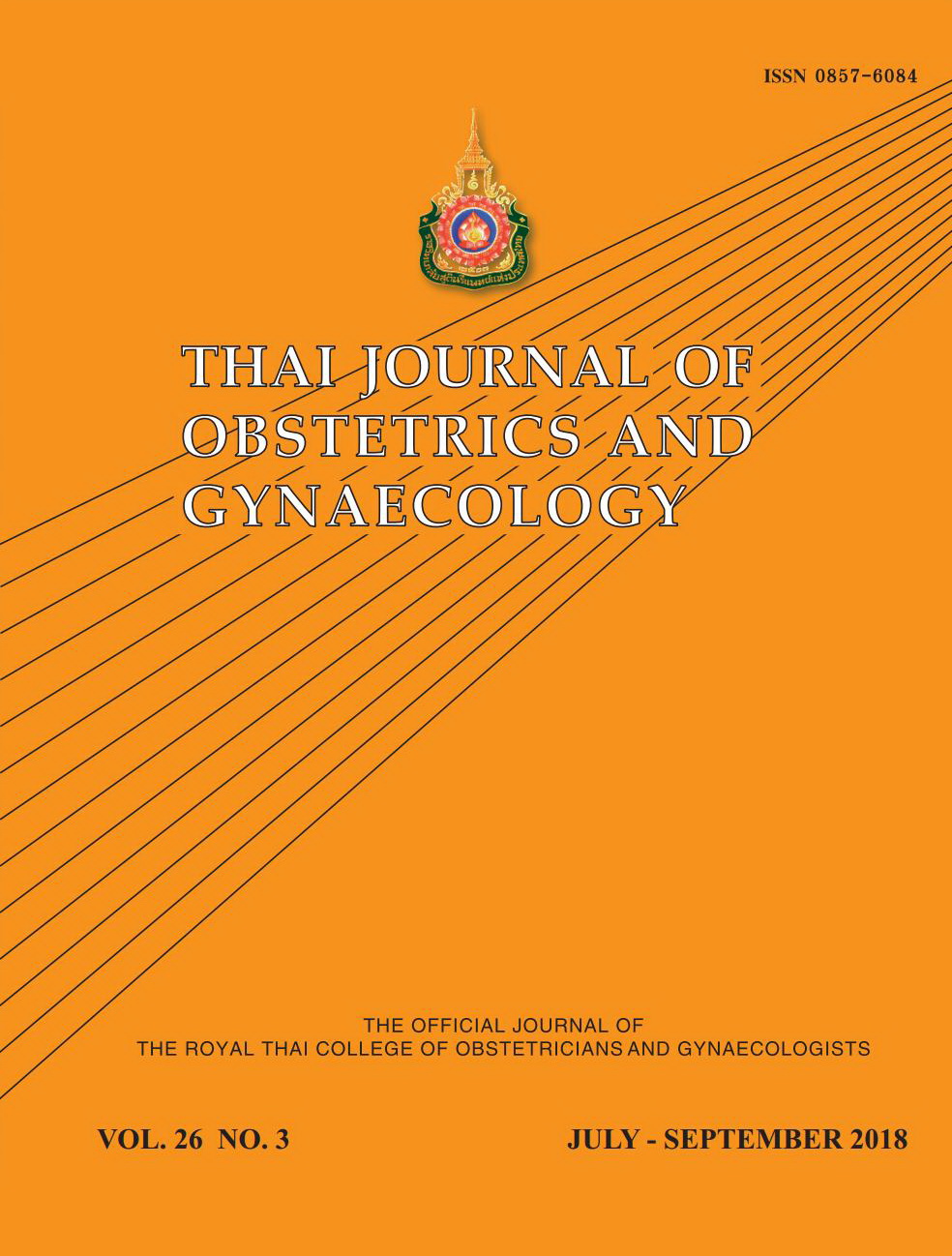Risk Factors for the Occurrence of Scalp Hematoma in Term Neonates in King Chulalongkorn Memorial Hospital
Main Article Content
Abstract
Objectives: To determine the incidence and associated factors of neonatal scalp hematoma.
Materials and Methods: This prospective case-control study included all term singleton live newborns that delivered in King Chulalongkorn Memorial Hospital during July 2016 to October 2016. All neonates were prospectively evaluated and divided into two groups: cases with scalp hematoma and controls. Diagnoses of neonatal scalp hematoma either cephalhematoma or subgaleal hemorrhage were confirmed by the experienced neonatologist. Medical records of these neonates and their mothers were reviewed to collect demographic data and information regarding their processes of labor and delivery. Logistic regression analysis was used to identify the risk factors associated with presence of neonatal scalp hematoma.
Results: A total of 938 term neonates were included in this study. The incidence of neonatal scalp hematoma was 3.19% (30/938) (95% CI 2.25-4.53). Operative obstetrics (vacuum and forceps extraction) were found to have the highest rate (15.38%) of scalp hematoma when compare with other routes of delivery. Factors associated with neonatal scalp hematoma were primiparity (adjusted OR 4.86, 95% CI 1.61-14.58) and prolonged second stage of labor (adjusted OR 4.31, 95% CI 1.08-17.25). When analysis was done in only vaginally delivered neonates, the significant factors were primiparity (adjusted OR 3.84, 95% CI 1.26-11.71) and artificial rupture of membranes (adjusted OR 2.93, 95% CI 1.24-6.97).
Conclusion: Neonatal scalp hematoma was common. Primiparous women significantly increased risk of neonatal scalp hematoma regardless of route of delivery.
Keywords: Birth injury, Cephalhematoma, Subgaleal hemorrhage, Term neonate
Article Details
References
2. Sauber-Schatz EK, Markovic N, Weiss HB, Bodnar LM, Wilson JW, Pearlman MD. Descriptive epidemiology of birth trauma in the United States in 2003. Paediatr Perinat Epidemiol 2010;24:116-24.
3. Abedzadeh-Kalahroudi M, Talebian A, Jahangiri M, Mesdaghinia E, Mohammadzadeh M. Incidence of neonatal birth injuries and related factors in Kashan, Iran. Arch Trauma Res 2015;4:e22831.
4. Reichard R. Birth injury of the cranium and central nervous system. Brain Pathol 2008;18:565-70.
5. Zimmermann P, Duppenthaler A. Infected cephalhaematoma in a five-week-old infant - case report and review of the literature. BMC Infect Dis 2016;16:636.
6. Colditz MJ, Lai MM, Cartwright DW, Colditz PB. Subgaleal haemorrhage in the newborn: A call for early diagnosis and aggressive management. J Paediatr Child Health 2015;51:140-6.
7. Swanson AE, Veldman A, Wallace EM, Malhotra A. Subgaleal hemorrhage: risk factors and outcomes. Acta Obstet Gynecol Scand 2012;91:260-3.
8. Carlo WA, Ambalavanan N. Nervous system disorders. in: Kliegman RM, Stanton BF, St Geme JW, Schor NF, editors. Nelson Textbook of Pediatrics, 20th ed. Philadelphia: Elsevier;2016:p 834-44.
9. Linder N, Linder I, Fridman E, Kouadio F, Lubin D, Merlob P, et al. Birth trauma-risk factors and short-term neonatal outcome. J Matern Fetal Neonatal Med 2013;26:1491-5.
10. Doumouchtsis SK, Arulkumaran S. Head trauma after instrumental births. Clin Perinatol 2008;35:69-83.
11. Baskett TF, Allen VM, O’Connell CM, Allen AC. Fetal trauma in term pregnancy. Am J Obstet Gynecol 2007;197:499.e1-7.
12. Moczygemba CK, Paramsothy P, Meikle S, Kourtis AP, Barfield WD, Kuklina E, et al. Route of delivery and neonatal birth trauma. Am J Obstet Gynecol 2010;202:361.e1-6.
13. Smyth RM, Markham C, Dowswell T. Amniotomy for shortening spontaneous labour. Cochrane Database of Systematic Reviews 2013, Issue 6. Art. No.: CD006167.
14. Committee on Obstetric Practice. Committee Opinion No. 687: Approaches to limit intervention during labor and birth. Obstet Gynecol 2017;129:e20-8.


